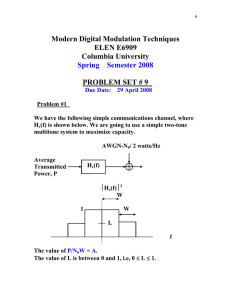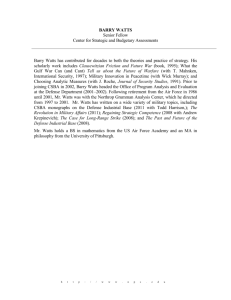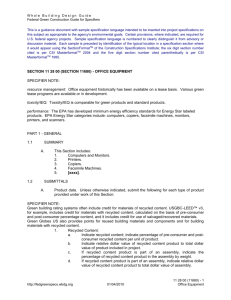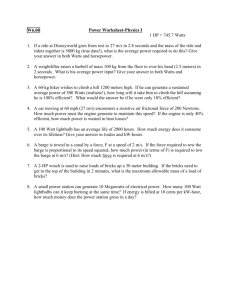Document 12043338
advertisement
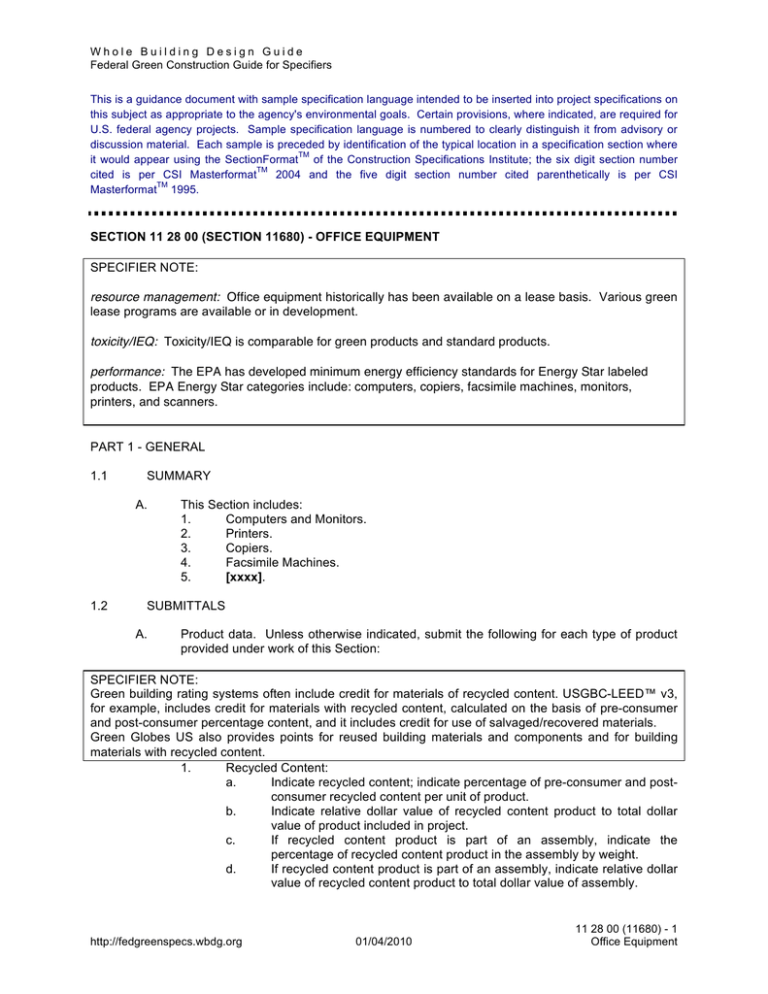
Whole Building Design Guide Federal Green Construction Guide for Specifiers This is a guidance document with sample specification language intended to be inserted into project specifications on this subject as appropriate to the agency's environmental goals. Certain provisions, where indicated, are required for U.S. federal agency projects. Sample specification language is numbered to clearly distinguish it from advisory or discussion material. Each sample is preceded by identification of the typical location in a specification section where TM it would appear using the SectionFormat of the Construction Specifications Institute; the six digit section number TM cited is per CSI Masterformat 2004 and the five digit section number cited parenthetically is per CSI TM Masterformat 1995. SECTION 11 28 00 (SECTION 11680) - OFFICE EQUIPMENT SPECIFIER NOTE: resource management: Office equipment historically has been available on a lease basis. Various green lease programs are available or in development. toxicity/IEQ: Toxicity/IEQ is comparable for green products and standard products. performance: The EPA has developed minimum energy efficiency standards for Energy Star labeled products. EPA Energy Star categories include: computers, copiers, facsimile machines, monitors, printers, and scanners. PART 1 - GENERAL 1.1 SUMMARY A. 1.2 This Section includes: 1. Computers and Monitors. 2. Printers. 3. Copiers. 4. Facsimile Machines. 5. [xxxx]. SUBMITTALS A. Product data. Unless otherwise indicated, submit the following for each type of product provided under work of this Section: SPECIFIER NOTE: Green building rating systems often include credit for materials of recycled content. USGBC-LEED™ v3, for example, includes credit for materials with recycled content, calculated on the basis of pre-consumer and post-consumer percentage content, and it includes credit for use of salvaged/recovered materials. Green Globes US also provides points for reused building materials and components and for building materials with recycled content. 1. Recycled Content: a. Indicate recycled content; indicate percentage of pre-consumer and postconsumer recycled content per unit of product. b. Indicate relative dollar value of recycled content product to total dollar value of product included in project. c. If recycled content product is part of an assembly, indicate the percentage of recycled content product in the assembly by weight. d. If recycled content product is part of an assembly, indicate relative dollar value of recycled content product to total dollar value of assembly. http://fedgreenspecs.wbdg.org 01/04/2010 11 28 00 (11680) - 1 Office Equipment Whole Building Design Guide Federal Green Construction Guide for Specifiers SPECIFIER NOTE: Specifying local materials may help minimize transportation impacts; however it may not have a significant impact on reducing the overall embodied energy of a building material because of efficiencies of scale in some modes of transportation. Green building rating systems frequently include credit for local materials. Transportation impacts include: fossil fuel consumption, air pollution, and labor. USGBC-LEED™ v3 includes credits for materials extracted/harvested and manufactured within a 500 mile radius from the project site. Green Globes US also provides points for materials that are locally manufactured. 2. Local/Regional Materials: a. Sourcing location(s): Indicate location of extraction, harvesting, and recovery; indicate distance between extraction, harvesting, and recovery and the project site. b. Manufacturing location(s): Indicate location of manufacturing facility; indicate distance between manufacturing facility and the project site. c. Product Value: Indicate dollar value of product containing local/regional materials; include materials cost only. d. Product Component(s) Value: Where product components are sourced or manufactured in separate locations, provide location information for each component. Indicate the percentage by weight of each component per unit of product. SPECIFIER NOTE: The EPA has developed minimum energy efficiency standards for Energy Star labeled products. EPA Energy Star categories include: appliances, HVAC, residential equipment, office equipment, and lighting. Note, EPEAT criteria includes compliance with provisions of the European RoHS Directive, Energy Star, and a corporate environmental policy consistent with ISO 14001. 3. Energy Efficiency: a. Submit documentation for Energy Star qualifications for equipment provided under work of this Section. B. Submit environmental data in accordance with Table 1 of ASTM E2129 for products provided under work of this Section. SPECIFIER NOTE: The Electronic Product Environmental Assessment Tool (EPEAT), a project of the Green Electronics Council, is a system that helps purchasers evaluate, compare and select electronic products based on their environmental attributes. The system currently covers desktop and laptop computers, thin clients, workstations and computer monitors. EPEAT evaluates electronic products in relation to 51 total environmental criteria (23 required and 28 optional) contained in IEEE 1680. To qualify for registration as an EPEAT product, the product must conform to all the required criteria. To qualify for registration as an EPEAT product, the product must conform to 23 environmental criteria, divided into eight categories: • Reduction/Elimination of Environmentally Sensitive Materials • Material Selection • Design for End of Life • Product Longevity/ Life Cycle Extension • Energy Conservation • End of Life Management • Corporate Performance • Packaging http://fedgreenspecs.wbdg.org 01/04/2010 11 28 00 (11680) - 2 Office Equipment Whole Building Design Guide Federal Green Construction Guide for Specifiers Criteria include compliance with provisions of the European RoHS Directive, Energy Star®, and a corporate environmental policy consistent with ISO 14001. Registered products are rated Gold, Silver or Bronze depending on the percentage of 28 optional criteria they meet above the baseline criteria. In EPEAT, manufacturers add their products to the registry by declaring that the products meet (or don’t meet) individual criteria of IEEE 1680. There is no verification of this declaration at the time the product is registered. In order to maintain the credibility of the declarations EPEAT periodically selects products from the registry and verifies that the product actually meets the criteria as declared. Refer to http://www.epeat.net//default.aspx C. Submit documentation that [desktop computers] [notebooks] [monitors] are registered with EPEAT for the level specified. SPECIFIER NOTE: Restriction of Hazardous Substances Directive (RoHS) 2002/95/EC [1] was adopted in February 2003 by the European Union. The RoHS directive, which took effect on July 1, 2006, restricts the use of six hazardous materials in the manufacture of various types of electronic and electrical equipment. It is closely linked with the Waste Electrical and Electronic Equipment Directive (WEEE) 2002/96/EC which sets collection, recycling and recovery targets for electrical goods and is part of a legislative initiative to solve the problem of huge amounts of toxic e-waste. The six materials are: • Lead • Mercury • Cadmium 6+ • Hexavalent chromium (chromium VI or Cr ) • Polybrominated biphenyls (PBB) • Polybrominated diphenyl ether (PBDE) European RoHS legislation imposes significant content restrictions on electronic products marketed in Europe. Similar measures have been enacted or proposed in a number of jurisdictions in Asia and Latin America, most notably, China. In the United States, California has also restricted the sale of certain products that are not EU RoHS compliant with many other states contemplating similar legislation aimed at the design and material content of electronic products. Refer to http://www.rohs.eu/english/index.html Note, EPEAT criteria includes compliance with provisions of the European RoHS Directive, Energy Star, and a corporate environmental policy consistent with ISO 14001. D. [Submit evidence of compliance with RoHS.] SPECIFIER NOTE: Identify special maintenance agreements. Maintenance agreements are standard practice in the building industry. Take-back programs refer to programs in which the product manufacturer “takes-back” scrap material and/or packaging associated with its product. Green leasing is a new, but dramatic shift in the traditional perspective of leased equipment. Under a green lease, the product manufacturer is responsible for the disposition of the product at all times. Thus, when the customer no longer requires the use of the particular product or requires an updated model, the manufacturer is obligated to reclaim it and refurbish it or disassemble it for recycling as appropriate. This approach necessitates a revision of administrative services. It also requires a basic redesign of products in order to allow for future disassembly and upgrade. This has the potential to be cost effective for manufacturers and customers alike. It is also extremely resource efficient. E. Documentation of manufacturer’s [maintenance agreement] [take-back program] [green lease] for each type of equipment. Include the following: 1. Appropriate contact information. 2. Overview of procedures. a. Indicate manufacturer’s commitment to reclaim materials for recycling and/or reuse. 3. Limitations and conditions, if any, applicable to the project. 1.3 MAINTENANCE http://fedgreenspecs.wbdg.org 01/04/2010 11 28 00 (11680) - 3 Office Equipment Whole Building Design Guide Federal Green Construction Guide for Specifiers SPECIFIER NOTE: Identify special maintenance agreements. Maintenance agreements are standard practice in the building industry. Take-back programs refer to programs in which the product manufacturer “takes-back” scrap material and/or packaging associated with its product. Green leasing is a new, but dramatic shift in the traditional perspective of leased equipment. Under a green lease, the product manufacturer is responsible for the disposition of the product at all times. Thus, when the customer no longer requires the use of the particular product or requires an updated model, the manufacturer is obligated to reclaim it and refurbish it or disassemble it for recycling as appropriate. This approach necessitates a revision of administrative services. It also requires a basic redesign of products in order to allow for future disassembly and upgrade. This has the potential to be cost effective for manufacturers and customers alike. It is also extremely resource efficient. A. Operational Service: Provide manufacturer’s [maintenance agreement] [take-back program] [green lease] service for each type of equipment installed in project. Service shall reclaim materials for recycling and/or reuse. Service shall not landfill or burn reclaimed materials. PART 2 - PRODUCTS SPECIFIER NOTE: EO 13423 includes requirements for Federal Agencies to use “sustainable environmental practices, including acquisition of biobased, environmentally preferable, energy-efficient, water-efficient, and recycled-content products” EO 13423 includes requirements for Federal Agencies to “… improve energy efficiency and reduce greenhouse gas emissions … by (i) 3 percent annually through the end of fiscal year 2015, or (ii) 30 percent by the end of fiscal year 2015, relative to the baseline of … year 2003” EO 13423 directs Federal Agencies to use electronic products that are “Electronic Product Environmental Assessment Tool (EPEAT)-registered electronic product[s], unless there is no EPEAT standard for such product” and that are Energy Star; additionally, EO 13423 directs Federal Agencies to use “environmentally sound practices with respect to disposition of agency electronic equipment that has reached the end of its useful life.” EO 13514; Federal Leadership in Environmental, Energy, and Economic Performance; was signed on October 5, 2009. http://www.ofee.gov/execorders.asp It expands upon the environmental performance requirements of EO 13423. EO 13514 sets numerous Federal requirements in several areas, including: • Ensure 95% of new contract actions, task orders, and delivery orders for products and services (excluding weapon systems) are energy efficient (ENERGY STAR® or FEMP-designated), water efficient, bio-based, environmentally preferable (Electronic Product Environmental Assessment Tool (EPEAT) certified), non-ozone depleting, contain recycled content, or are non-toxic or less-toxic alternatives where such products and services meet agency performance requirements. 2.1 EQUIPMENT A. Computers and Monitors: SPECIFIER NOTE: Computers: An ENERGY STAR labeled computer, in sleep mode, uses 70 percent less electricity than computers without power management features. If left inactive, ENERGY STAR qualified computers enter a low-power mode and use 15 watts or less. Monitors: An ENERGY STAR labeled monitor, in sleep mode, uses 90 percent less electricity than monitors without power management features. FEMP provides recommendations for energy efficiency of office equipment. Recommendations address “sleep” or “standby” mode of operation. Where available, federal agencies are required to purchase products that use one watt of power or less while in standby mode. For some products, FEMP sets a separate standby level. http://fedgreenspecs.wbdg.org 01/04/2010 11 28 00 (11680) - 4 Office Equipment Whole Building Design Guide Federal Green Construction Guide for Specifiers 1. 2. Energy Efficiency: Provide Energy Star labeled products. Environmental performance in accordance with IEEE 1680 and the EPEAT Registry: a. Computers: Provide EPEAT [Bronze] [Silver] [Gold] products [and comply with FEMP efficiency recommendations as indicated below]. FEMP Efficiency Recommendation Maximum Continuous Power Recommended "Sleep" Mode Power Supply Rating (or system type) <= 200 watts 15 watts or less 201-300 watts 20 watts or less 301-350 watts 25 watts or less 351-400 watts 30 watts or less >400 watts <= 10% of maximum power supply rating PC/Monitor (all in one) 35 watts or less b. Notebooks: Provide EPEAT [Bronze] [Silver] [Gold] products. c. Monitors: Provide EPEAT [Bronze] [Silver] [Gold] products[and comply with FEMP efficiency recommendations as indicated below]. FEMP Efficiency Recommendation Recommended "Sleep Best Available "Sleep Mode" Mode" 15 watts or less 1 watt 15 watts or less 1 watt 15 watts or less 2 watts Product Type 14" - 15" Color 17" Color 20" - 21" Color [3. Provide electronic equipment that is RoHS compliant.] B. Printers: SPECIFIER NOTE: Printers: Printers that have earned the ENERGY STAR can cut the equipment's electricity use by over 60 percent. 1. Energy Efficiency: Provide Energy Star labeled products [and comply with FEMP efficiency recommendations as indicated below]. Printer Speed ≥ 10 pages/min. 11-20 pages/min 21-30 pages/min 31-44 pages/min > 44 pages/min [2. FEMP Efficiency Recommendation Recommended "Sleep" Mode Laser B/W + All Inkjet Laser Color 10 watts or less 35 watts or less 20 watts or less 45 watts or less 30 watts or less 70 watts or less 40 watts or less> 70 watts or less 75 watts or less 70 watts or less Provide electronic equipment that is RoHS compliant.] C. Copiers: SPECIFIER NOTE: Copiers: Copiers that have earned the ENERGY STAR "sleep" or power down when not in use, and use 40 percent less electricity compared to standard models. http://fedgreenspecs.wbdg.org 01/04/2010 11 28 00 (11680) - 5 Office Equipment Whole Building Design Guide Federal Green Construction Guide for Specifiers ENERGY STAR labeled high-speed copiers feature duplexing units that automatically make double-sided copies, reduces paper costs by about $60 a month. Using less paper also saves energy because it takes 10 times more energy to manufacture a piece of paper than it does to copy an image onto it. 1. Energy Efficiency: Provide Energy Star labeled products [and comply with FEMP efficiency recommendations as indicated below]. FEMP Efficiency Recommendation Recommended Best Available Copier Type (copies/minute) Automatic Duplex Copying Watts in "Sleep" Mode Watts in Off Mode Watts in "Sleep" Mode Watts in Off Mode <=20 cpm N/A 5 or less 0 0 N/A 21-44 cpm 5 + (cpm * 3.85) or less 15 or less 0 Default Setting > 44 cpm 5 + (cpm * 3.85) or less 20 or less 0 Default Setting [2. cpm * 3.0 or less cpm * 1.3 or less Provide electronic equipment that is RoHS compliant.] D. Facsimile Machines: SPECIFIER NOTE: Faxes: fax machines that have earned the ENERGY STAR can reduce energy costs associated with fax machine use by almost 40 percent 1. Energy Efficiency: Provide Energy Star labeled products [and comply with FEMP efficiency recommendations as indicated below]. FEMP Efficiency Recommendation Recommended "Sleep" Best Available "Sleep" Mode Mode All Types Inkjet Laser, LED Fax Speed ≥10 pages/min. >10 pages/min. [2. 10 watts or less 1 watt 2 watts 15 watts or less 2 watts 2 watts Provide electronic equipment that is RoHS compliant.] PART 3 - EXECUTION 3.X SITE ENVIRONMENTAL PROCEDURES A. Resource Management: 1. Energy Efficiency: Verify equipment is properly installed, connected, and adjusted. Verify that equipment is operating as specified. 2. Coordinate with manufacturer for [maintenance agreement] [take-back program] [green lease]. END OF SECTION http://fedgreenspecs.wbdg.org 01/04/2010 11 28 00 (11680) - 6 Office Equipment
